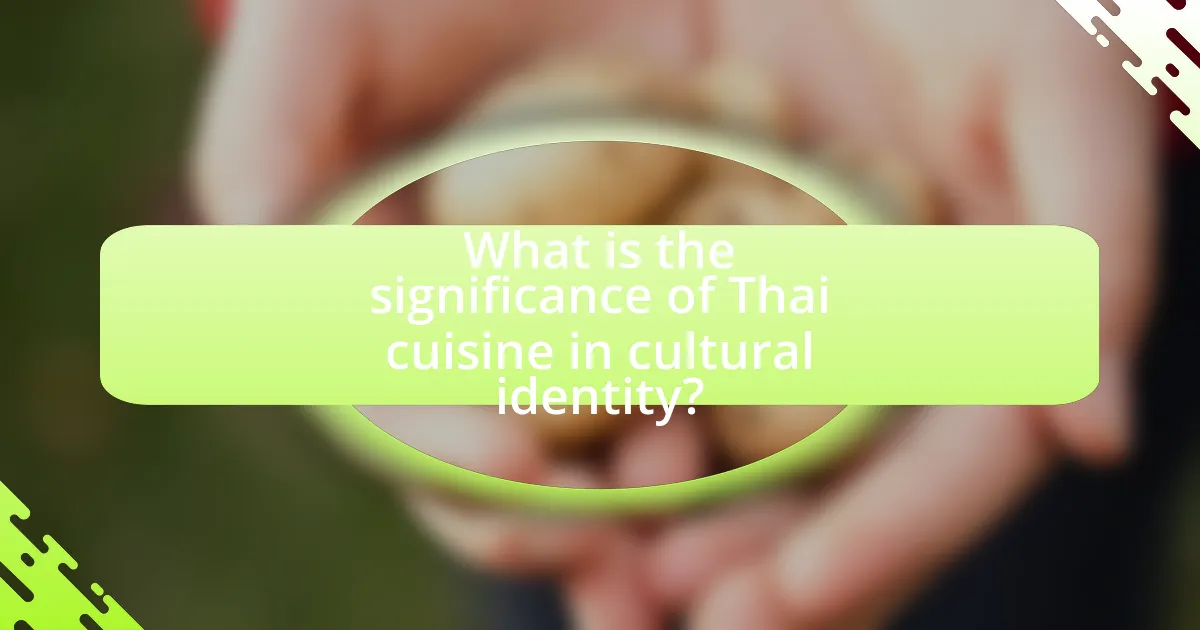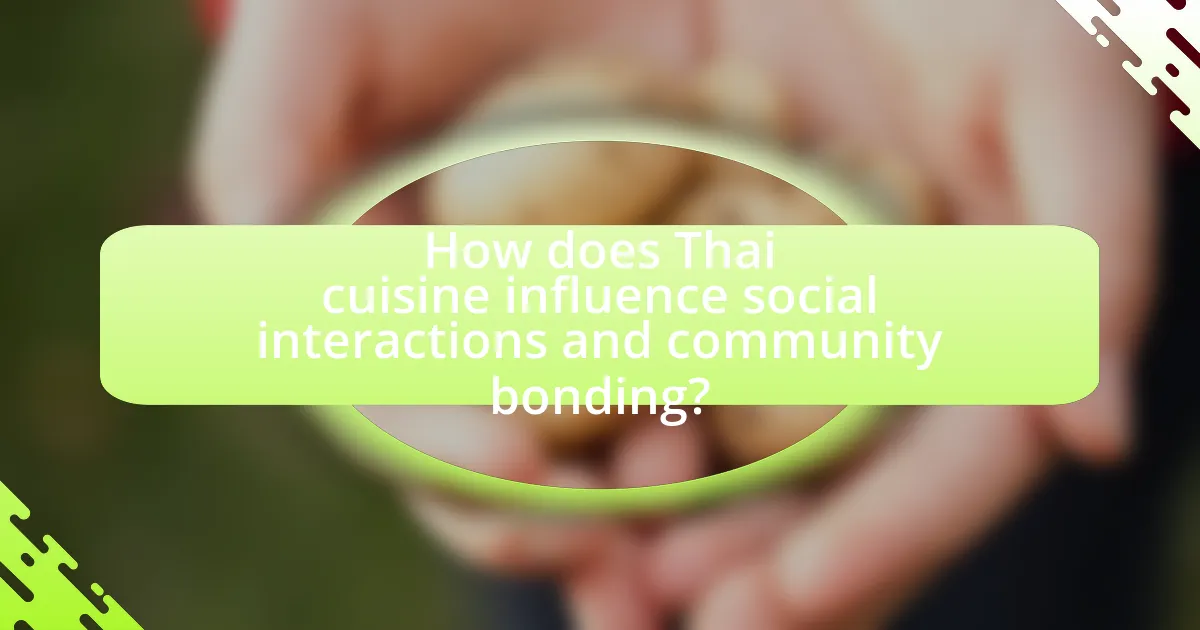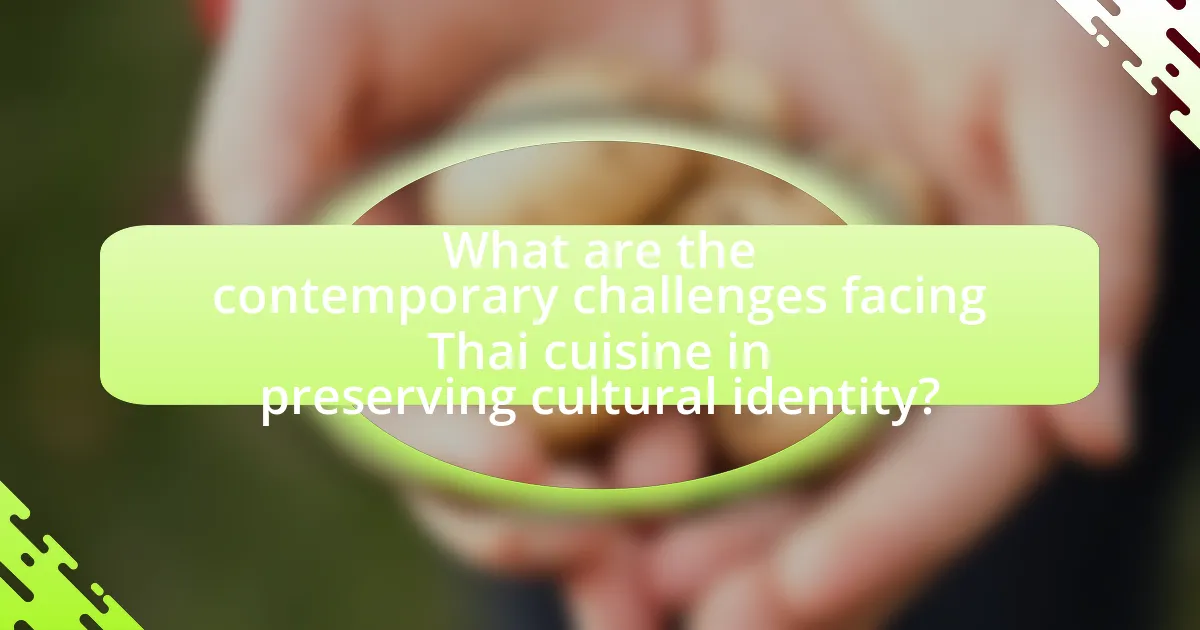Thai cuisine plays a crucial role in shaping cultural identity in Thailand, reflecting the country’s history, traditions, and social values through its diverse flavors and communal dining practices. The article explores how regional variations in Thai food represent local cultures and the influence of historical events on culinary practices. It also examines the significance of food in celebrations and rituals, the impact of globalization on traditional cooking, and the efforts being made to preserve authentic culinary traditions. Additionally, the article highlights the importance of education and community initiatives in maintaining the integrity of Thai cuisine while promoting its appreciation both locally and internationally.

What is the significance of Thai cuisine in cultural identity?
Thai cuisine is significant in cultural identity as it embodies the country’s history, traditions, and social values. The diverse flavors and ingredients reflect regional variations and the influence of neighboring cultures, showcasing Thailand’s agricultural richness and culinary heritage. For instance, the use of fresh herbs and spices not only enhances flavor but also signifies the importance of health and balance in Thai culture. Additionally, communal dining practices highlight the value placed on family and social connections, reinforcing cultural bonds. The global popularity of Thai food further emphasizes its role as a cultural ambassador, promoting understanding and appreciation of Thai identity worldwide.
How does Thai cuisine reflect the history and traditions of Thailand?
Thai cuisine reflects the history and traditions of Thailand through its diverse ingredients, cooking techniques, and regional variations that have evolved over centuries. The influence of historical trade routes, such as those with China and India, introduced spices and cooking methods that are now integral to Thai dishes. For example, the use of chili peppers, which were brought to Thailand from the Americas in the 16th century, has become a defining characteristic of Thai flavor profiles. Additionally, traditional practices like the use of fresh herbs and communal dining highlight the importance of family and community in Thai culture. Festivals and religious ceremonies also play a significant role, as specific dishes are prepared to honor traditions and celebrate cultural heritage, such as the preparation of sticky rice during the Loy Krathong festival. Thus, Thai cuisine serves as a living testament to the country’s rich history and cultural identity.
What historical events have shaped Thai culinary practices?
Historical events that have shaped Thai culinary practices include the influence of trade, the introduction of foreign ingredients, and the impact of royal cuisine. The establishment of trade routes in the 15th century facilitated the exchange of spices and cooking techniques, leading to a diverse culinary landscape. The arrival of Portuguese traders in the 16th century introduced new ingredients such as chili peppers, which became integral to Thai cooking. Additionally, the royal courts, particularly during the Ayutthaya and Rattanakosin periods, emphasized refined culinary techniques and presentation, further shaping the cuisine. These events collectively contributed to the rich tapestry of flavors and practices that define Thai cuisine today.
How do regional variations in Thai cuisine represent local cultures?
Regional variations in Thai cuisine reflect local cultures through distinct ingredients, cooking methods, and flavor profiles that are influenced by geography, climate, and historical trade. For instance, the use of fresh seafood and coconut milk in Southern Thai dishes showcases the coastal environment and agricultural practices of that region. In contrast, Northern Thai cuisine emphasizes the use of herbs and spices, reflecting the mountainous terrain and cultural exchanges with neighboring countries like Myanmar and Laos. Additionally, the spiciness of dishes in the Northeast, or Isan region, highlights the influence of Lao culinary traditions, while the central region’s cuisine often features sweeter flavors, indicative of its agricultural abundance. These variations not only illustrate the diversity of Thailand’s landscapes but also embody the unique cultural identities and traditions of each region.
In what ways does Thai cuisine contribute to national pride?
Thai cuisine contributes to national pride by showcasing the country’s rich cultural heritage and culinary diversity. The use of fresh ingredients, unique flavors, and traditional cooking techniques reflects Thailand’s agricultural abundance and regional variations. For instance, dishes like Pad Thai and Tom Yum are not only popular domestically but have gained international recognition, symbolizing Thailand’s global culinary influence. Additionally, the annual Thai Food Festival celebrates local dishes and promotes Thai culinary traditions, reinforcing a sense of identity and pride among citizens. This cultural significance is further emphasized by the inclusion of Thai cuisine in UNESCO’s list of Intangible Cultural Heritage, highlighting its importance in representing Thai culture on a global stage.
How is Thai cuisine perceived internationally?
Thai cuisine is perceived internationally as a vibrant and flavorful representation of Thailand’s cultural identity. Its distinct use of fresh herbs, spices, and a balance of sweet, sour, salty, and spicy flavors has garnered global popularity, making dishes like Pad Thai and Tom Yum Soup staples in many countries. According to a 2020 survey by the World Food Travel Association, Thai food ranks among the top five most popular cuisines worldwide, reflecting its widespread appreciation and influence. This international recognition not only highlights the culinary techniques and ingredients unique to Thailand but also fosters a greater understanding of Thai culture and traditions.
What role do food festivals play in promoting Thai culinary heritage?
Food festivals play a crucial role in promoting Thai culinary heritage by showcasing traditional dishes and cooking techniques to a broad audience. These events serve as platforms for local chefs and home cooks to demonstrate their culinary skills, thereby preserving and revitalizing age-old recipes and practices. For instance, the annual Bangkok Street Food Festival highlights regional specialties, attracting both locals and tourists, which fosters appreciation for the diversity of Thai cuisine. Additionally, food festivals often include cultural performances and workshops, further educating attendees about the historical and cultural significance of the dishes being presented. This multifaceted approach not only enhances public awareness but also strengthens community ties through shared culinary experiences.

How does Thai cuisine influence social interactions and community bonding?
Thai cuisine significantly influences social interactions and community bonding by serving as a central element in communal gatherings and celebrations. The act of sharing meals, such as during festivals or family gatherings, fosters connections among individuals, reinforcing social ties and cultural identity. For instance, traditional dishes like Pad Thai or Tom Yum are often prepared in large quantities for communal consumption, encouraging participation and collaboration in the cooking process. This shared experience not only enhances relationships but also preserves cultural heritage, as recipes and cooking techniques are passed down through generations, solidifying community bonds.
What are the traditional dining customs in Thailand?
Traditional dining customs in Thailand emphasize communal eating, where meals are shared among family and friends. This practice reflects the Thai value of togetherness and harmony, often featuring a variety of dishes served simultaneously, allowing diners to sample different flavors. Additionally, it is customary to eat with a fork and spoon, using the fork to push food onto the spoon, which is then used to bring food to the mouth. This method is rooted in Thai etiquette, where the spoon is considered the primary utensil for eating. Furthermore, meals typically begin with a prayer or a moment of gratitude, highlighting the cultural significance of respect for food and those who prepared it.
How do communal meals foster relationships among families and friends?
Communal meals foster relationships among families and friends by creating shared experiences that enhance bonding and communication. When individuals gather to share food, they engage in conversations, express emotions, and build memories together, which strengthens their connections. Research indicates that shared meals can lead to improved family dynamics and social cohesion, as evidenced by a study published in the Journal of Marriage and Family, which found that families who eat together regularly report higher levels of satisfaction in their relationships. This collective dining experience not only promotes a sense of belonging but also reinforces cultural traditions, particularly in contexts like Thai cuisine, where communal eating is integral to social interactions.
What is the significance of food in Thai celebrations and rituals?
Food holds a central significance in Thai celebrations and rituals as it symbolizes community, gratitude, and cultural identity. In various Thai festivals, such as Songkran and Loy Krathong, specific dishes are prepared to honor deities and ancestors, reflecting the importance of food in expressing respect and devotion. For instance, during Songkran, families prepare traditional dishes like Khao Chae, which is served to welcome the new year, emphasizing the connection between food and seasonal celebrations. Additionally, the act of sharing meals during these events fosters social bonds and reinforces cultural traditions, making food an integral part of Thai communal life and identity.
How does the preparation and sharing of food enhance cultural identity?
The preparation and sharing of food enhance cultural identity by serving as a means of expressing traditions, values, and social connections within a community. In Thai culture, for example, the communal aspect of dining, where dishes are shared among family and friends, reinforces social bonds and reflects the importance of hospitality. This practice is rooted in the Thai concept of “sanuk,” which emphasizes enjoyment and togetherness during meals. Furthermore, specific ingredients and cooking methods used in Thai cuisine, such as the balance of flavors and the use of fresh herbs, are deeply tied to regional identities and historical influences, showcasing the diversity within Thai culture. The act of preparing traditional dishes, such as Pad Thai or Tom Yum, not only preserves culinary heritage but also fosters a sense of belonging and pride among individuals, thereby solidifying cultural identity.
What skills are passed down through generations in Thai cooking?
Essential skills passed down through generations in Thai cooking include the mastery of balancing flavors, traditional cooking techniques, and the use of fresh, local ingredients. These skills are crucial for creating authentic Thai dishes, which emphasize the harmony of sweet, sour, salty, and bitter tastes. The importance of these skills is evidenced by the fact that many Thai families have recipes and cooking methods that have been preserved for centuries, often taught from parent to child, ensuring the continuity of cultural identity through cuisine.
How do cooking classes and culinary tourism promote cultural exchange?
Cooking classes and culinary tourism promote cultural exchange by facilitating direct interaction between individuals from different backgrounds through shared culinary experiences. These activities allow participants to learn about and engage with the cooking techniques, ingredients, and traditions of a specific culture, such as Thai cuisine. For instance, a study by the World Food Travel Association found that 93% of travelers believe that food is an essential part of experiencing a culture, highlighting the importance of culinary experiences in fostering understanding and appreciation of diverse cultural practices. Through hands-on cooking classes, participants not only acquire new skills but also gain insights into the cultural significance of the dishes they prepare, thereby enhancing cross-cultural communication and appreciation.

What are the contemporary challenges facing Thai cuisine in preserving cultural identity?
Contemporary challenges facing Thai cuisine in preserving cultural identity include globalization, commercialization, and the dilution of traditional recipes. Globalization has led to the widespread adaptation of Thai dishes, often resulting in variations that stray from authentic flavors and techniques. Commercialization, driven by the tourism industry, prioritizes profit over cultural integrity, leading to the proliferation of restaurants that serve inauthentic versions of Thai food. Additionally, the younger generation’s preference for fast food and convenience often results in a decline in the transmission of traditional cooking methods and recipes, threatening the cultural heritage associated with Thai cuisine. These factors collectively contribute to the erosion of the unique identity that Thai cuisine represents.
How is globalization affecting traditional Thai culinary practices?
Globalization is significantly influencing traditional Thai culinary practices by introducing diverse ingredients and cooking techniques from around the world. This integration leads to the fusion of traditional Thai flavors with international cuisines, resulting in new dishes that may deviate from authentic recipes. For instance, the popularity of Western fast food has prompted some Thai restaurants to adapt their menus, incorporating items like burgers and pizzas, which can overshadow traditional dishes. Additionally, the rise of social media and food tourism has increased exposure to global culinary trends, prompting chefs to innovate while sometimes sacrificing authenticity. This shift reflects a broader trend where cultural identity is both preserved and transformed in response to global influences.
What adaptations are being made to Thai cuisine in response to global trends?
Thai cuisine is adapting to global trends by incorporating healthier ingredients, embracing plant-based options, and enhancing fusion dishes. These adaptations reflect a growing consumer demand for nutritious meals and sustainability. For instance, many Thai restaurants are now offering vegan versions of traditional dishes like Pad Thai and Green Curry, which cater to the increasing popularity of plant-based diets worldwide. Additionally, the use of organic and locally sourced ingredients is becoming more prevalent, aligning with global trends towards health-conscious eating. This shift not only preserves the essence of Thai flavors but also meets the evolving preferences of a diverse, health-oriented audience.
How do chefs balance tradition and innovation in Thai cooking?
Chefs balance tradition and innovation in Thai cooking by incorporating modern techniques and ingredients while respecting traditional recipes and flavors. This approach allows chefs to create dishes that honor the rich heritage of Thai cuisine, such as using classic ingredients like lemongrass and galangal, while also experimenting with contemporary culinary methods like sous-vide or fusion elements. For instance, many chefs are now blending traditional Thai flavors with international cuisines, which reflects the evolving nature of food culture in Thailand. This balance is essential for maintaining cultural identity while appealing to a global audience, as evidenced by the increasing popularity of Thai street food in fine dining settings.
What efforts are being made to preserve authentic Thai culinary traditions?
Efforts to preserve authentic Thai culinary traditions include government initiatives, educational programs, and community-based projects. The Thai government has implemented the “Thai Food Culture Preservation Project,” which aims to promote traditional cooking methods and ingredients through workshops and culinary schools. Additionally, organizations like the Thai Culinary Academy offer courses that emphasize the importance of regional dishes and techniques. Community efforts, such as local food festivals and farmer’s markets, also play a crucial role in showcasing and sustaining traditional recipes and practices, ensuring that they remain a vital part of Thailand’s cultural identity.
How do local organizations and communities support traditional food practices?
Local organizations and communities support traditional food practices by promoting local ingredients, hosting cultural events, and providing educational programs. These initiatives help preserve culinary heritage and encourage the use of traditional cooking methods. For example, community-supported agriculture programs connect local farmers with consumers, ensuring the availability of indigenous produce. Additionally, festivals celebrating Thai cuisine, such as the annual Thai Food Festival, showcase traditional dishes and cooking techniques, fostering community engagement and cultural pride. Educational workshops organized by local NGOs teach younger generations about traditional recipes and their significance, reinforcing cultural identity through food.
What role does education play in maintaining the integrity of Thai cuisine?
Education plays a crucial role in maintaining the integrity of Thai cuisine by preserving traditional cooking techniques and cultural knowledge. Culinary schools and programs in Thailand emphasize the importance of authentic recipes, ingredient sourcing, and regional variations, ensuring that future chefs understand the historical and cultural significance of the dishes they prepare. For instance, institutions like the Culinary Institute of Thailand teach students about the origins of Thai ingredients and the traditional methods of preparation, which helps to sustain the culinary heritage. This educational framework not only fosters respect for the cuisine but also encourages innovation within the boundaries of tradition, thereby maintaining the integrity of Thai culinary practices.
What practical tips can individuals follow to appreciate and promote Thai cuisine?
To appreciate and promote Thai cuisine, individuals can explore authentic Thai cooking classes, which provide hands-on experience with traditional ingredients and techniques. Engaging in these classes enhances understanding of the cultural significance of dishes like Pad Thai and Tom Yum, which reflect Thailand’s rich culinary heritage. Additionally, individuals can support local Thai restaurants by dining there regularly and sharing their experiences on social media, thereby increasing visibility for these establishments. Research indicates that community engagement with local cuisine fosters cultural appreciation and strengthens community ties, as seen in studies on culinary tourism. By participating in Thai food festivals or cultural events, individuals can further immerse themselves in the cuisine while promoting its cultural identity.
